
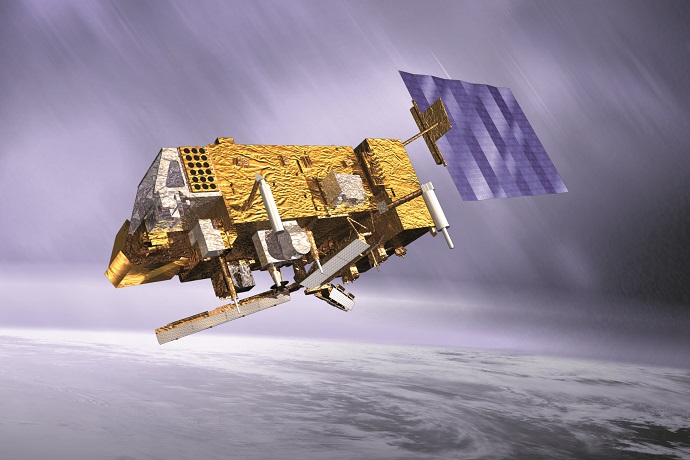
The Metop-A satellite was part of a constellation of three satellites: Metop-A, -B and -C. (Image: ESA/EUMETSAT)
EUMETSAT has started to decommission the Metop-A satellite, which has brought tremendous benefits to numerical weather prediction (NWP) after it was launched 15 years ago.
Metop-A was Europe’s first operational polar-orbiting satellite and the first in a series of three satellites of the EUMETSAT Polar System (EPS) programme covering the mid-morning orbit.
It was packed with a suite of novel and advanced instruments, such as IASI, ASCAT, GRAS and GOME-2, as well as valuable heritage sensors, such as AMSU-A, MHS, HIRS and AVHRR.
With the combined use of all these instruments, Metop-A was arguably the most influential meteorological satellite of its generation.
Follow-on Metop satellites (Metop-B launched in 2012 and Metop-C in 2018) offered extra benefits, useful resilience and new products based on the dual exploitation of satellite pairs. They will be relied upon until a new generation of Metop platforms is launched.
Improved forecasts
All weather observations received by ECMWF make a contribution to forecast quality by helping to determine the initial conditions of weather forecasts. This process is called data assimilation. Satellite data make a particularly large contribution to it.
The combined use of data from Metop satellites represented on average nearly 45% of observations used at ECMWF and accounted for around 27% of the total impact of all observations assimilated by the Centre.
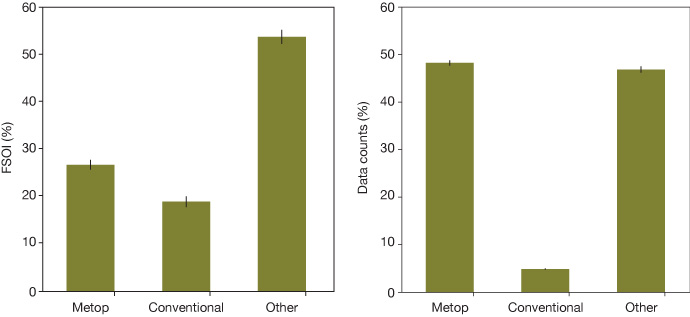
Contribution of Metop satellites, conventional observations and the rest of the observing system to the reduction of forecast error as estimated by Forecast Sensitivity to Observation Impact (FSOI – left) and used data counts (right) in May 2020.
Using more than one Metop satellite had an additional positive impact. However, due to the highly overlapping coverage the additional impact is not as large as the one achieved when assimilating the first Metop satellite.
The use of more than one satellite did provide a healthy resilience in the observing system against instrument failure: it shielded the assimilation from intermittent outages affecting individual satellites or instruments.
The plots below from 2013 show the percentage reduction in root-mean-square error of adding just Metop-A and both Metop-A and Metop-B to the observing system.
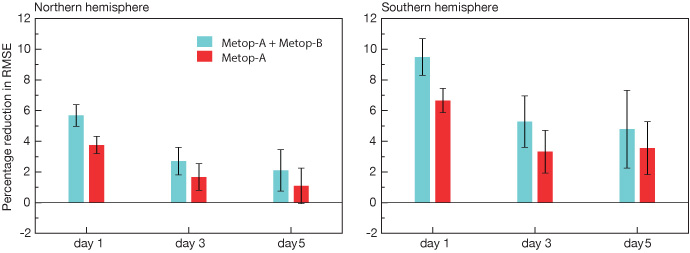
Impact by hemisphere of adding two Metop satellites to the baseline system in 2013. The plots show the percentage reduction in root-mean-square error (RMSE) of 500 hPa geopotential height at days 1, 3 and 5 in the northern and southern hemisphere extratropics as a result of assimilating just Metop-A and both Metop-A and Metop-B. The error bars are 95% confidence intervals and represent the statistical significance of the improvements with respect to the ‘no Metop’ baseline experiment.
Data from Metop helps to constrain many aspects of the atmosphere in the forecasting model: the vertical distribution of temperature, humidity and indirectly the wind (IASI, AMSU-A, MHS and GRAS); surface winds (ASCAT); surface moisture over land (ASCAT); atmospheric winds (AVHRR); and ozone (GOME-2).
Derived products from IASI, GOME-2 and AVHRR are used to monitor and constrain many aspects of atmospheric composition.
Novel instruments
The IASI instrument was the first infrared interferometer sounder with high spectral resolution (8461 channels). It was designed to measure temperature and water vapour profiles in addition to the concentration of other infrared-absorbing constituents.
Throughout its lifetime, the instrument has proven to be fit for operations with stable performance and a consistent positive impact.
Due to the configuration of assimilation systems and available resources, only an evolving subset of the most informative IASI channels was used.
In addition to using radiances for NWP, ECMWF uses several datasets derived from IASI for producing the Copernicus Atmosphere Monitoring Service (CAMS) global analyses, forecasts and reanalyses, including CO, CO2 and CH4 and, in test mode, ozone and SO2.
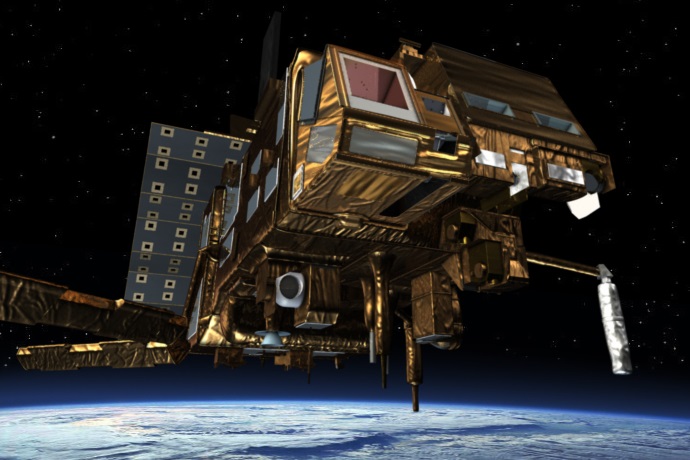
IASI, which can be seen here in the top left corner of the satellite, has been useful for both NWP and atmospheric composition monitoring. (Image: ESA - AOES Medialab)
ASCAT was a new generation scatterometer instrument designed primarily to measure surface wind over oceans. The data are also useful to derive soil moisture over land.
The instrument is equipped with two sets of three antennae allowing simultaneous measurements to be made from three directions to reduce the wind direction ambiguity.
Similar to IASI, ASCAT data started to be used about a year after launch and provided a reliable service afterwards. For extended periods, ASCAT was the only scatterometer providing marine surface winds.
Research is ongoing into the use of surface stress, which is closer to what the instrument is measuring. Such work would allow ASCAT data to impact both the atmosphere and the ocean in the context of coupled data assimilation.
GRAS was the first fully operational European GNSS radio occultation mission, following on from successful research missions such as CHAMP.
The instrument is designed to measure temperature profiles and tropospheric humidity using refracted GPS signals. GRAS data are used by ECMWF in the form of bending angles and provide profiles of the atmosphere.
The consistent availability of GNSS-RO data helped fill large observation gaps in the stratosphere.
The GOME-2 instrument is designed to provide information on total column and vertical profiles of ozone as well as other species, such as NO2, SO2 and aerosols – the latter in combination with information also from IASI and AVHRR (Polar Multi-sensor Aerosol optical Properties product, PMAP).
Total column ozone is used in the ECMWF atmospheric assimilation system. More products (ozone, aerosols and SO2) are used by the CAMS analysis system.
High reliability
EUMETSAT provided operational support for Metop-A, leading to very high availability and good timeliness as well as speedy communication regarding anomalies and maintenance operations.
The dual and subsequently triple exploitation of Metop satellites was performed in a way to maximise the benefits for NWP. This was achieved by choosing complementary orbits and generating dual products, such as global Atmospheric Motion Vectors.
EUMETSAT managed to extend the lifetime of the Metop-A satellite well beyond its life expectancy, without noticeably compromising the performance of the instruments.
The figure below illustrates the temporal stability of the performance of one of the channels from Metop-A AMSU-A.
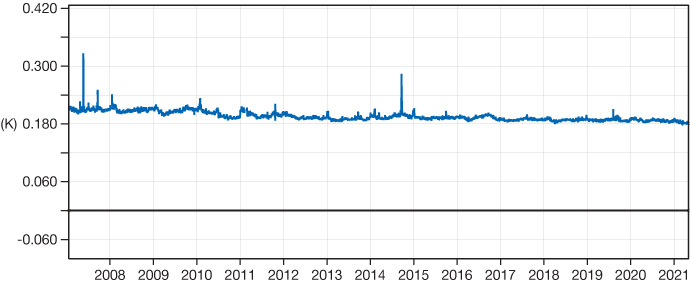
Time series of the standard deviation of first-guess departures (observations minus a short-range forecast) for channel 9 from Metop-A AMSU-A.
Metop-A was a very successful operational satellite that had a tremendous impact on NWP. Indeed, its success has been key to securing substantial investment to launch the second generation of Metop platforms in the mid-twenties.
These will carry even more sophisticated technology to support operational NWP, but also to accelerate our understanding of Earth system science.
